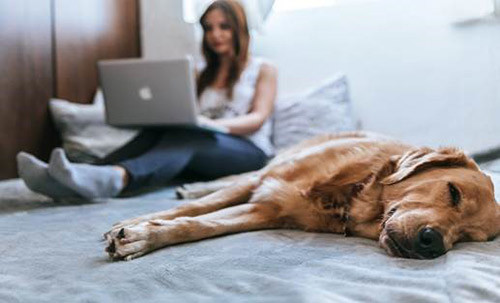 With social distancing and staying at home the new norm, we, and our dogs, are experiencing head-spinning lifestyle changes. Chances are we’re spending more time on the couch, crunching on more chips and moving less – all of which can be tough on our waistline and joints.
With social distancing and staying at home the new norm, we, and our dogs, are experiencing head-spinning lifestyle changes. Chances are we’re spending more time on the couch, crunching on more chips and moving less – all of which can be tough on our waistline and joints.
The silver lining is that we’re spending more time with our dogs, and can do more than ever to help get them into top shape during this downtime.
Chad Dodd, veterinarian for YuMOVE (a clinically proven* hip and joint supplement for dogs) says, “Fifty percent of dogs across America already are overweight (at least 10%-20% over their ideal weight), and 80% of dogs over seven have joint and mobility conditions, but now is the time to better manage our dog’s diet, exercise and overall mobility.”
Here are some of Dr. Dodd’s quick tips for our homebound pooch:
Diet tips:
• Slice up some fresh carrots and other veggies like green beans, peas, celery and cucumbers (skip the onions because they’re toxic for dogs).
• Try feeding your dog half a banana, apple or pear instead of part of your steak or fries.
• Toss some blueberries in a bowl – a superfood rich in antioxidants.
• Chop up some cantaloupe.
• Reduce your pet’s kibble by about 10 or 20 pieces. You’ll be helping them keep trim and they won’t notice the difference.
Activity tips:
• No matter what size house or apartment, find 15 minutes twice a day and walk at a decent pace through your home with your dog. It gets your pet and you moving.
• Play hide and seek. Hide some kibble or favorite toys around your home and let your dog find them.
• Play tag with your dog. This can be done in a hallway, basement or backyard. Grab your dog’s favorite soft toy, give it a toss, except this time, race your dog to retrieve it.
• If you have stairs and your dog is mobile, go up and down the stairs with them twice a day for about five to 10 minutes.
• If the weather is nice and you have a terrace or backyard, get some fresh air while you power walk around the area. Add in some intervals of jogging, sprinting or lunges to spice it up.
Keep an eye out for the signs of stiff joints:
• A change in the way your dog walks or runs, different posture or slowing down on their daily walk.
• Reluctance to jump up or down onto the sofa (or somewhere they’re allowed to jump).
• Slow or struggling to get up after rest.
• Avoiding or nervous on slippery surfaces such as laminate floors.
• Licking at their joints.
• Unexplained ‘pacing,’ often at night.
Mobility tips – how you can help:
• Consider making changes to your home environment to make it easier for your dog to move about. Non-slip mats and ramps on the stairs can make a real difference.
• Think about their joint supplement options – is your dog getting the right level of joint support for their age? Look out for high Omega 3 levels, such as ActivEase Green Lipped Mussel.
• Make sure they are at the right weight for their breed. 52% of dogs with joint problems are also overweight.
• Keep them active. Staying active is a big part of being able to stay active – and we all know how Fido loves to run, jump and play.
• Talk to your veterinarian and they can advise on a suitable management plan including the above and alternatives such as hydrotherapy.
Here is audio of Chad Dodd on keeping your dog healthy and fit while working from home.
Click here for video of Chad Dodd’s tips on alternative treats, exercise and joint health.
For more helpful pet care tips visit www.yumove.com.
*Study conducted by The Royal Veterinary College, London, 2016






